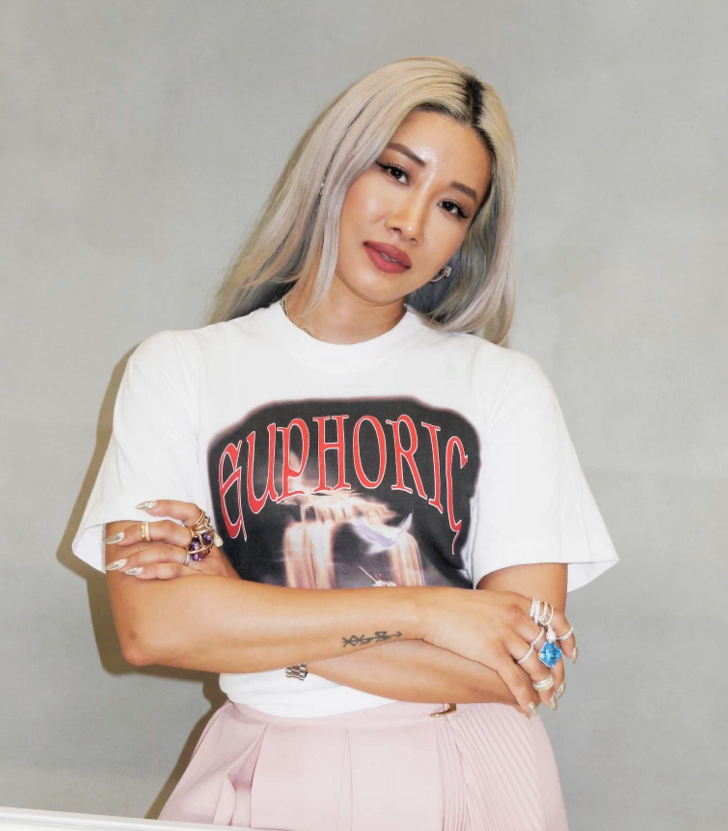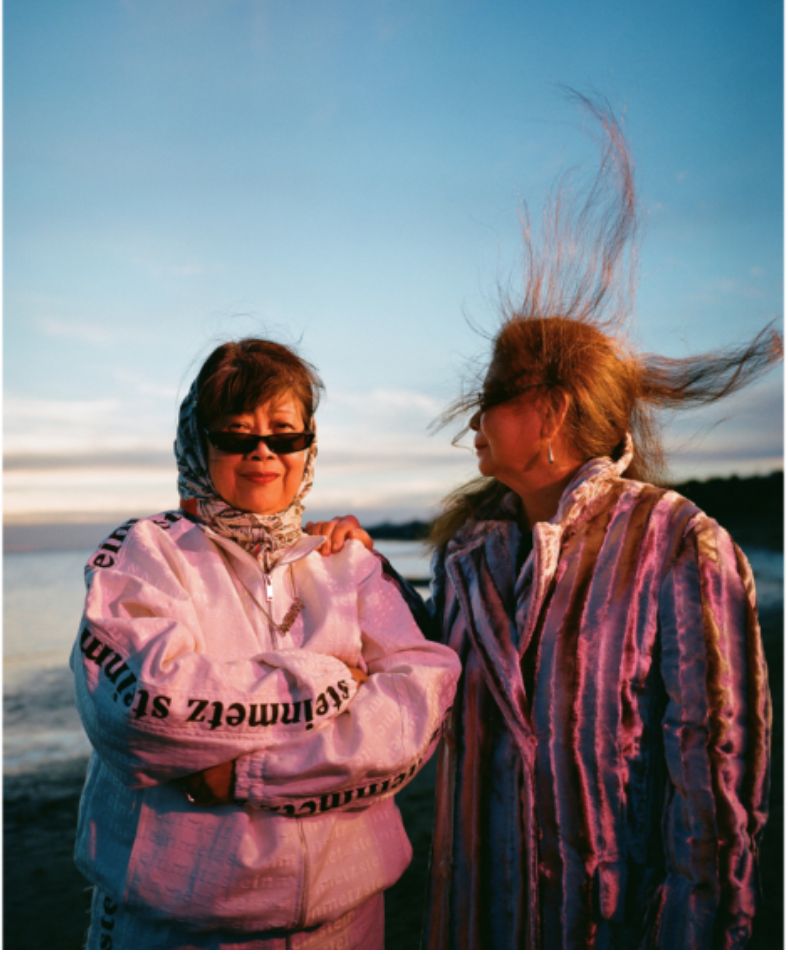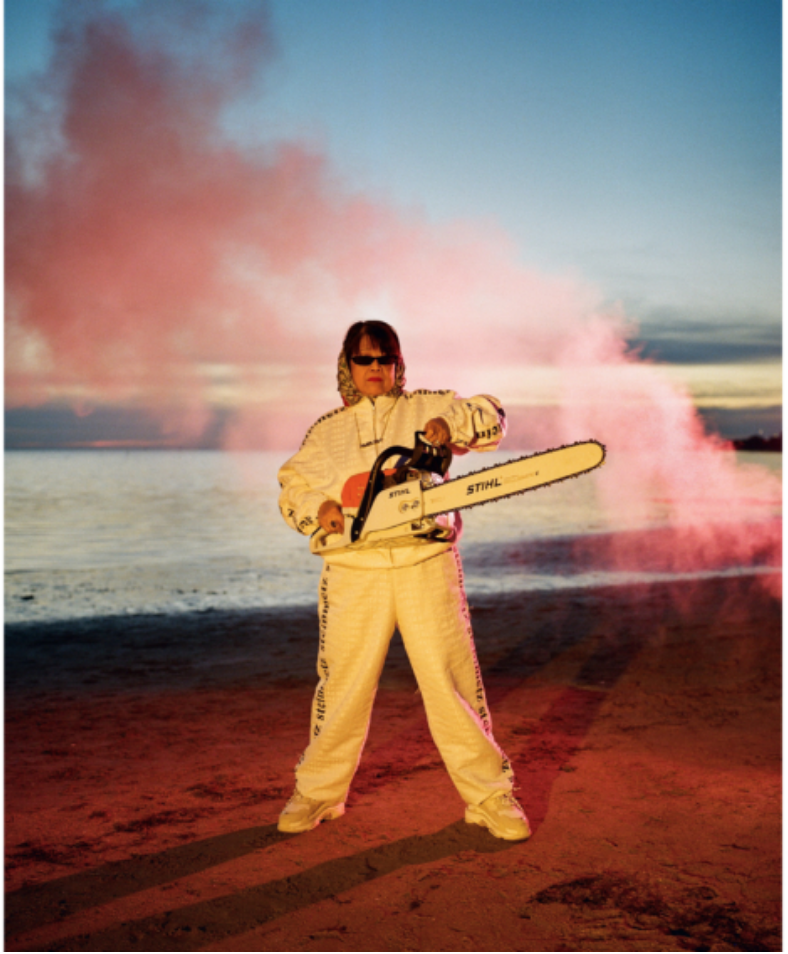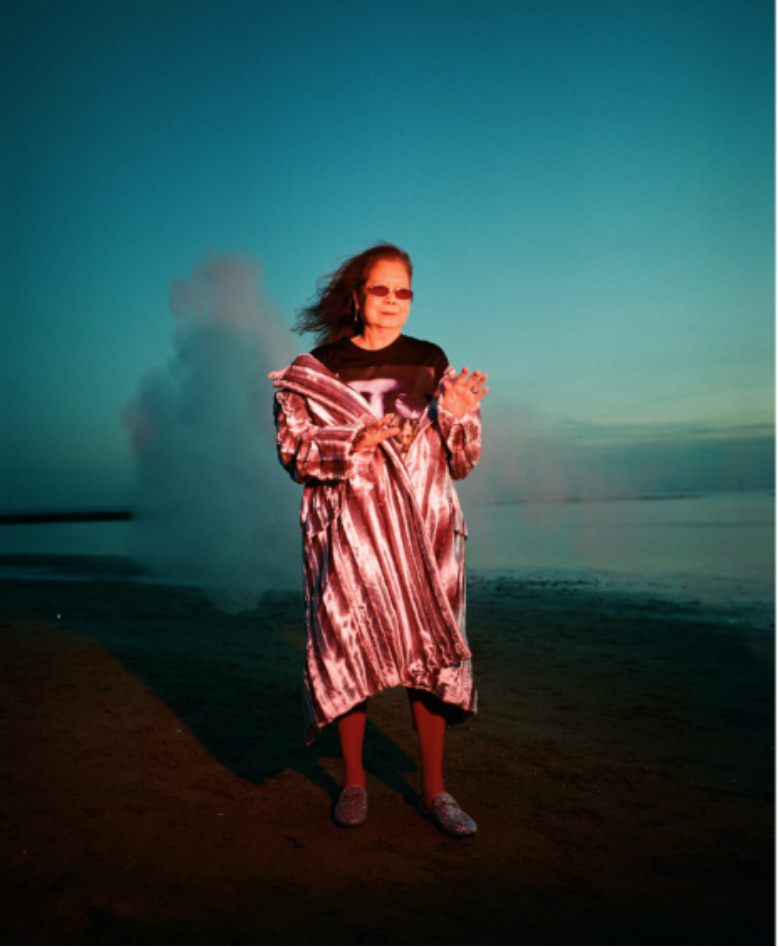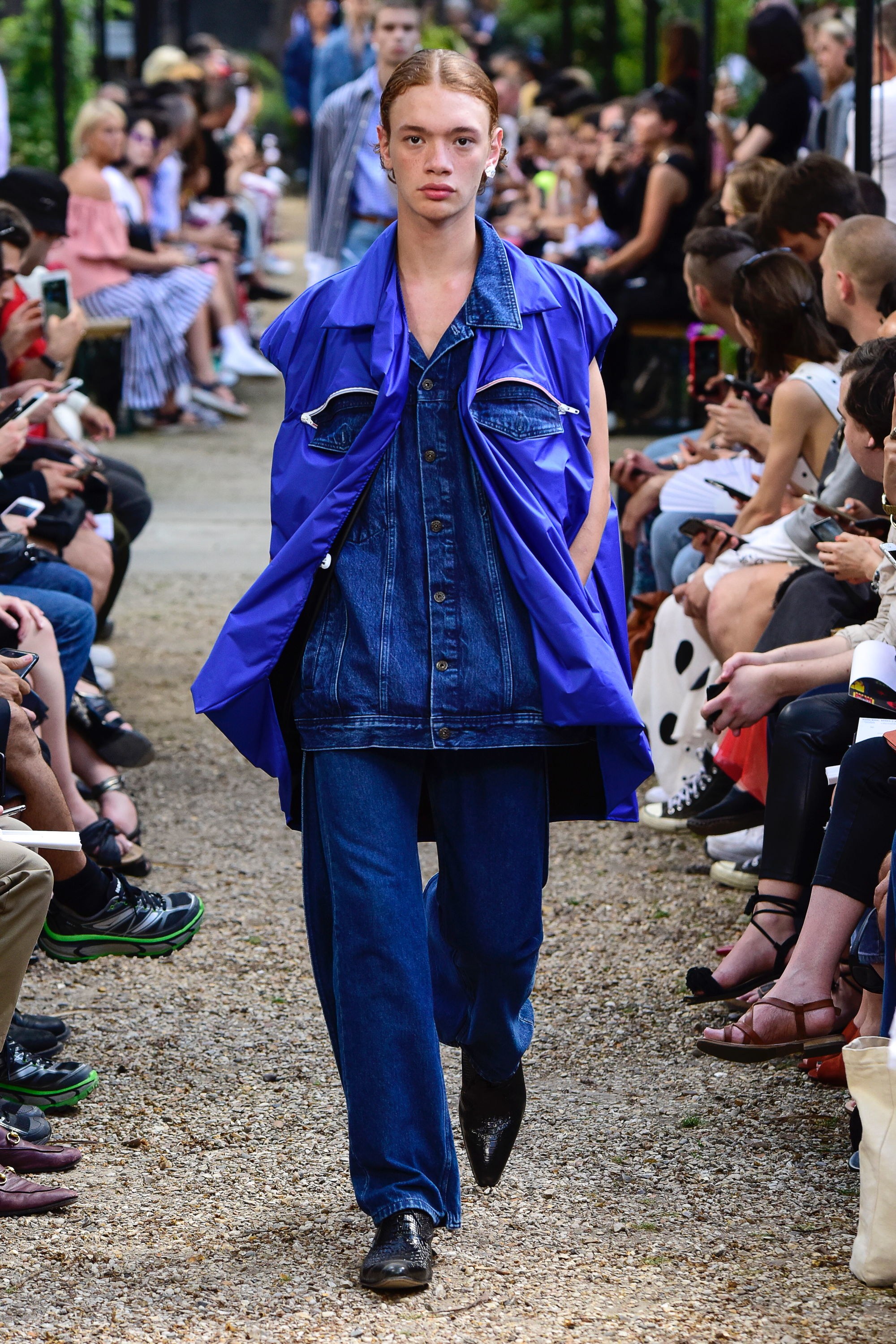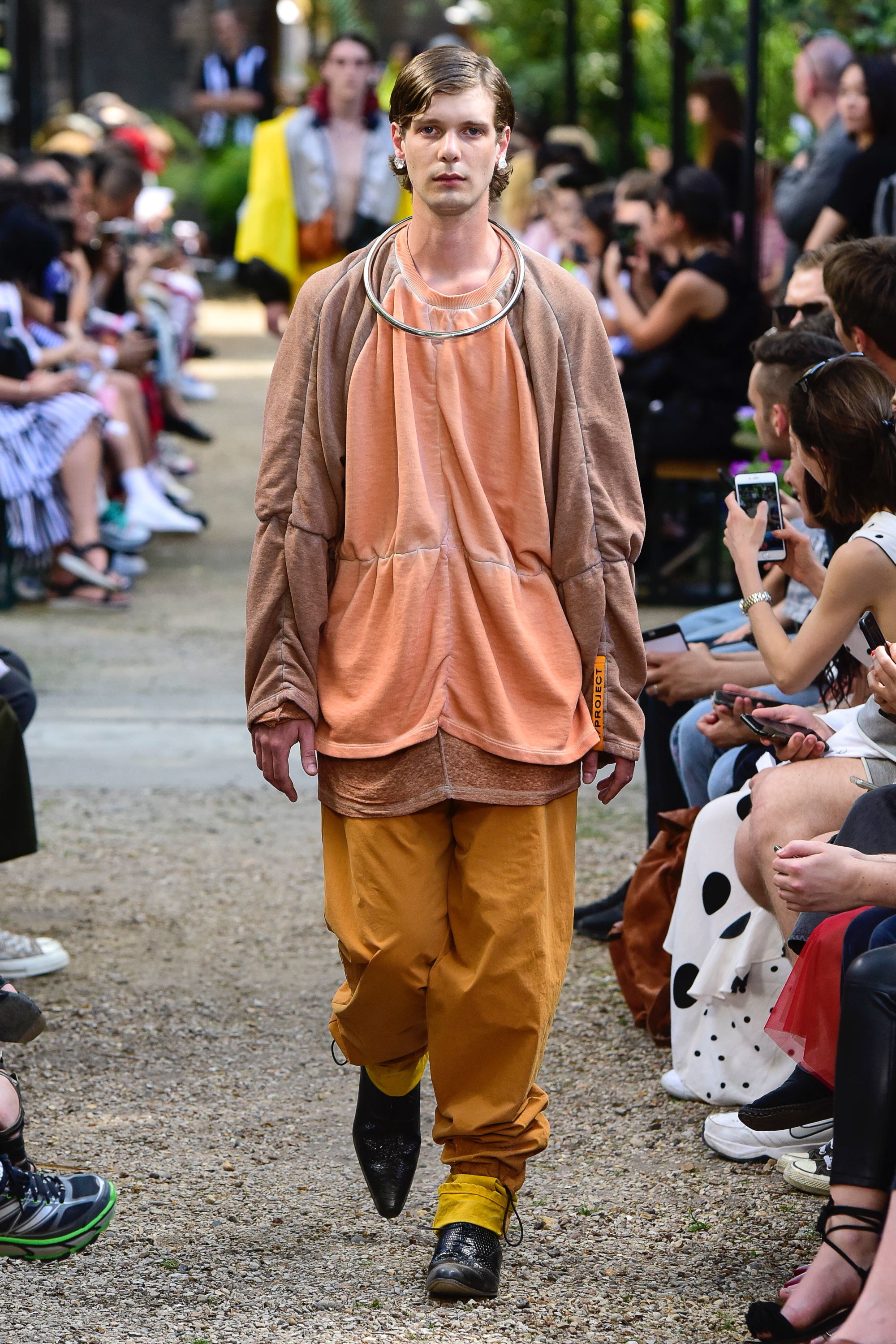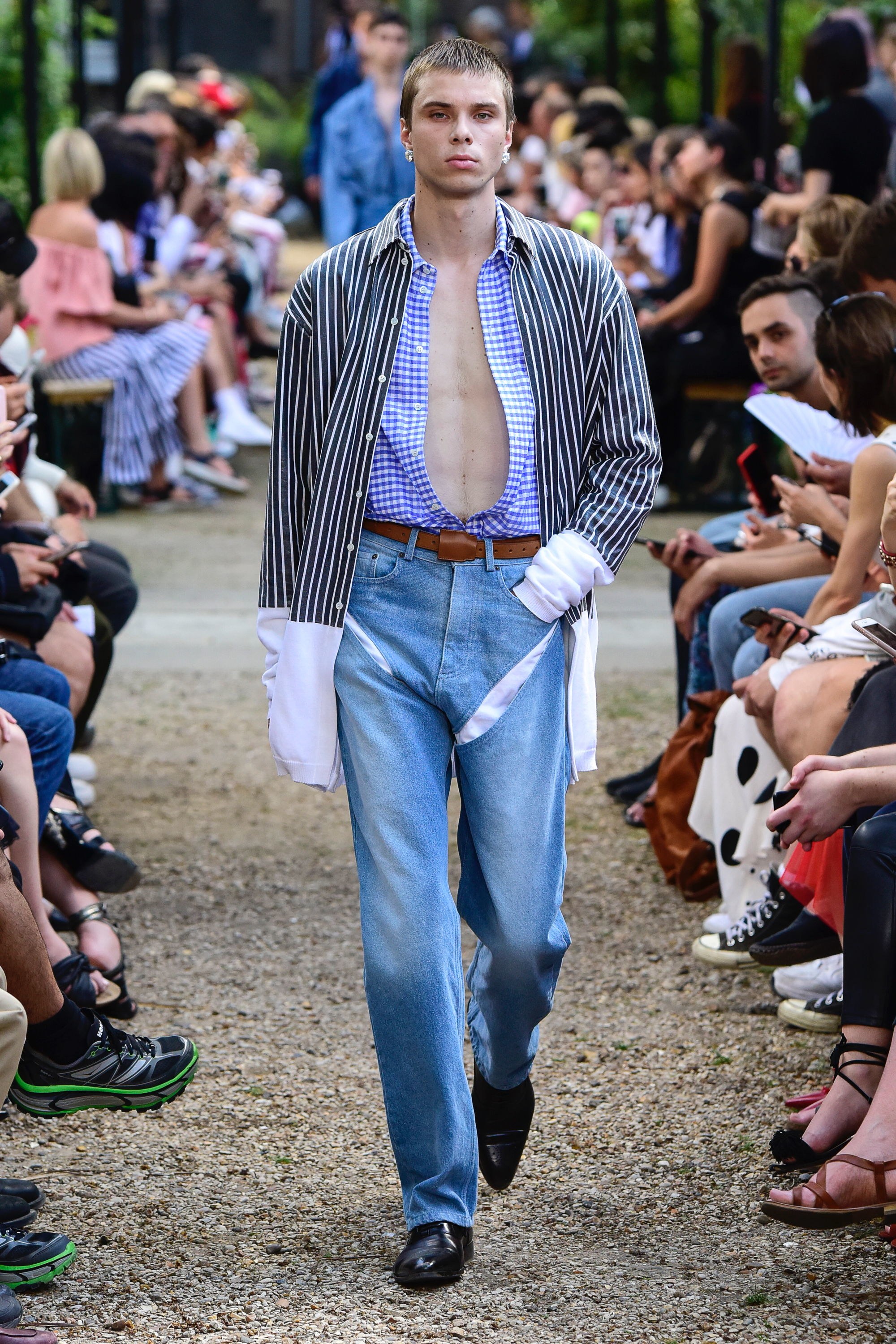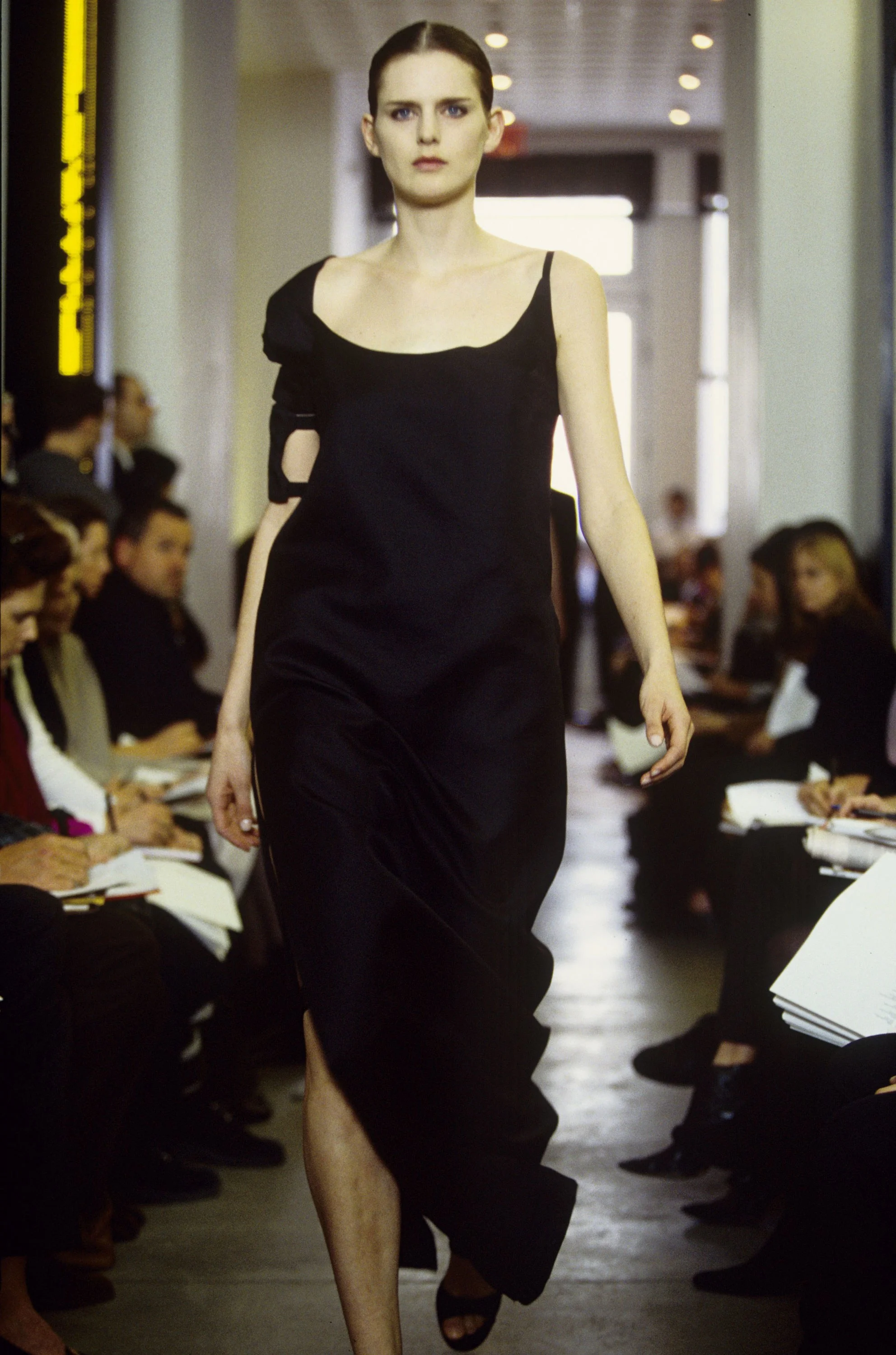MOLLY GODDARD SS19 /
Molly Goddard is our kind of girl.
All good vibes and inner confidence, she dresses to please herself. Just listen to how Goddard describes her SS19 muse as “slightly flush… unsure whether it’s down to sunburn or the cevezas, but she doesn’t care it becomes her.” It certainly does.
Frills, created by gathering tens of metres of cotton into architectural volumes were the name of the game here. It’s what Goddard is know for, but she injected plenty of newness. How about a pair of Molly Goddard culottes with an explosion of ruffles at the hem, or an unstructured tulle housecoat? There were fully sequinned options too including a teeny tiny skater dress which conjoined the bad girl attitude of Tonya Harding.
Speaking of bad girls, Goddard introduced a vamp element, with slashed-to-the-waist frilled party dresses. There was plenty to please the Goddard super fans, who tuned up in their voluminous smocked finery but it was also great to see Goddard push her aesthetic with new shapes and structures. We raise a glass of ceveza to that.
Words by Claudia Croft for 10 Magazine
FROM WEST COAST GRUNGE TO SHIBUYA TO DIOR: YOON AHN’S WORLD TAKEOVER /
Her Accessories and Streetwear Are All Over Rihanna and Kanye, and Paris’ Runways, Too. In Tokyo, the Dior Homme Jeweller Shares Her Path to Success.
I catch Yoon Ahn exactly one week after the debut of her inaugural jewelry collection for Dior Homme Spring/Summer 2019 at Paris fashion week. She was back in her home base of Tokyo for just eight days and was scheduled to leave for London to start work on next seasons collection the following morning. On this, the sweltering last day of June, we meet in Shibuya, at the AMBUSH Workshop—Yoon’s jewelry turned ready-to-wear label.
Like a growing number of her peers, the 41-year-old designer wasn’t formally trained. She started out making jewelry for fun with her husband Verbal, a member of the Japanese rap group the Teriyaki Boyz who gained popularity in 2005. Back then, rap had yet to become the new pop. Japanese streetwear was mixing with 90s hip-hop style—full-zip Bape hoodies, varsity jackets, stunner shades, baggy denim, and LA Gear high-tops. Their work channeled the “golden era” of rap with whopping gold chains and Slick Rick rings. Picture a thick gold chain with a medallion the shape of Beethoven’s bust, wearing diamond-encrusted shades and a studded leather jacket. Kanye and Pharrell were two of the first American rappers to embrace this scene, spending lots of time in Japan, collaborating with the Teriyaki Boyz, and wearing Yoon and Verbal’s designs. Nostalgic extravagance was in, and thanks in part to perfect timing and high-profile co-signs, the jewelry took off.
Eight years after the birth of AMBUSH jewelry came a full AMBUSH ready-to-wear collection, an LVMH nomination in 2017, a Tokyo fashion week presentation in 2018, and announced last spring, the appointment to jewelry designer for Dior Homme, courtesy of its newly-minted creative director Kim Jones, a long-time friend of Yoon’s.
The AMBUSH Workshop in Shibuya is comprised of two stories, doubling as a retail location on street level, and an office on the second floor. I wander into the retail space and there are at least 10 shoppers inside, two are studying a binder filled with images of AMBUSH jewelry offerings, one is glued to a rack of graphic tees with unicorn and wolf illustrations that read “Euphoric Oblivion” and “Traces to Nowhere." Yoon’s designs are a hybrid of soft and hard. She’ll take a pop can and crush it, turning it into a purse. Or she’ll take a fitted hat with a generic sports insignia and give it an exaggerated romantic brim, creating a sunhat. A lifejacket becomes a puffer jacket, or a matching fleece sweatsuit gets fitted and tailored to become a viable going-out look. There’s a poetic nature in her work that comes not from subtlety, but from grand gestures.
I’m escorted upstairs by a very friendly and unassuming assistant dressed in an outfit that skews more corporate than AMBUSH, into a small but bright lobby. It’s minimally decorated with a table and chairs, and a small rolling rack of AMBUSH clothing in the corner. I’m resisting the urge to touch when Yoon emerges promptly through a white door, calmly sipping on a Starbucks iced tea. In this 40 degree Tokyo heat, staving off my immense jetlag, I’m dripping in sweat and she’s dripping in jewelry—the crystals in her rings making her look Ultra HD like she just stepped out of the screen on a 4K television. On each hand, huge aqua blue and violet purple square crystals encased in gold and silver. There’s more. On almost every finger and knuckle, at least 10 thin diamond bands, two of which have diamond-covered teardrops dangling off of them as if they’re crying. Her long talon nails match, gleaming in a shade of champagne silver.
Yoon grew up in Seattle “before it was hip,” she says. Pre-Starbucks, pre-Amazon, the Seattle that birthed the grunge-era. The overcast sky made it an easy place to get depressed, Yoon says, and she didn’t want anything to do with that. Born in 1977 in Korea, Yoon is the oldest of two—her father in the U.S. Army and her mother a homemaker. Her dad’s job took them to Hawaii and California before they settled in the Seattle suburbs in the 80s. “I was obsessed with Eddie Vedder,” recalled Yoon of her West Coast adolescence, a telling comment that makes sense of the grunge-inspired details often present in her work. “I can appreciate Seattle, but back then I used to hate it so much.” Yoon grew obsessed with New York City and London and the world she saw in the pages of i-D, Vogue, and The Face.
After high school, instead of heading to New York or London, she ended up at Boston University to study graphic design, a move that turned out to be pivotal in her life. It was here, in the late 90s, that she met her husband Verbal at church. “Christianity and going to church is big in Korean culture, and I grew up in a Christian family,” says Yoon. “So when I went to Boston I was looking for a church and that's where we met.” This chance meeting—call it God’s plan, or the law of attraction—would become a pattern in Yoon’s life. It was 2003 when she made the jump to Tokyo, and things kept clicking. Kanye wore their AMBUSH ‘POW!’ pendant—an XL diamond rendering of the classic comic book speech bubble— and suddenly they were fielding calls from international fashion buyers. She also met Virgil through Kanye, back when both guys were interns at Fendi. Kanye introduced her to Kim Jones too around this time, backstage at a Teriyaki Boyz show. This was ten years ago. Pre-YEEZY, pre-Virgil mania, pre-Kim Jones at Louis Vuitton.
"FASHION IS POP CULTURE NOW, SO YOU HAVE TO BE THE JUGGLER, IN THE FRONT."
Paris men’s fashion week Spring/Summer 2018 was historic for the aforementioned group. Kim Jones presented his inaugural collection for Dior Homme with Yoon, Virgil Abloh held the most hyped fashion show of the year for Louis Vuitton, and Kanye West showed up to support. Friends for a decade that are all finding themselves on top at the same time. Like the Antwerp Six for the insta-generation. Together, they’re redefining what a designer can be and simultaneously sparking a massive cultural debate. Is it simply friendship, or design codependency? Would the new breed of fashion designer/creative director be successful on their own, without a hyped crew to back them up? “As a designer today you have to be the best marketing person, the best PR person, you have to do everything,” says Yoon. “It's not about designing anymore, because there's more expectation on you than ever before. Fashion is pop culture now, so you have to be the juggler, in the front.”
With her appointment to Dior Homme Jewelry designer, Yoon balances two jobs and is responsible for twice the amount of output, a reality that she admits worries her without preoccupying her. Her working relationship with Kim Jones is particularly fruitful because of their long-term friendship. “He sets the tone for the collection and what he wants to do, and it's my job to come up with ideas to complement the directions he's taking.”
Much has been written about high fashion’s current changing of the guard, and Yoon is undeniably a key player in this new luxury establishment, but surprisingly, early into our conversation, she expresses that she isn’t sure of that herself. “I don't know if I'm a key player or not. I'm not trying to be that person, but I do feel responsible, in a way, now that I've been given this platform to exercise my philosophy.”
When we meet she’s wearing the AMBUSH tee that says “Euphoric Oblivion” but it’s tucked into a pink pleated skirt so that only the word “Euphoric” is visible. There’s a fluidity to the way she styles her own designs, accentuating their meaning. Her fans follow her lead, call it aspirational-Yoon. It becomes obvious to me why she's referred to by her brand, Yoon AMBUSH, instead of Yoon Ahn. Her selfies are magnetic, too. KiraKira, the faux sparkle app, even looks different on her—it’s shining out of her eyes. Bella and Gigi Hadid, Simi and Haze, the Kardashians, and the Jenners all want to wear her clothes. They want to be friends with her too. “I’m obsessed with you,” Bella comments on a selfie that Yoon posted in June, depicting herself and her cat both glowing like cosmic deities.
Yoon’s early days of peacocking on the Tokyo club circuit have primed her for the realities of the industry. “Sometimes, when people don't know you, they judge you by what you post, and how you seem to appear. That's why you also need to understand that surface is surface. Once someone opens that lid, they're going to be seeking depth. I might look a certain way on social media. I'm a girl, at the end of the day, and I like to have long weaves and wear lipstick, but I make sure I work my ass off, and my results are there. Everything in life is a balance. Especially as a creator, you need to lead with results.”
When AMBUSH held their first presentation at Tokyo fashion week in March of this year, the crowd was indicative of Yoon’s natural ability to draw like-minded people into her world, especially in a city like Tokyo where fashion industry elites don’t usually make time for up-and-comers. “All these different people from different industries came out. Chitose from Sacai, to Jun from Undercover, to Hiroshi Fujiwara, to J-Pop idols, to Kiko Mizuhara. I don't think there was an event where all those types of people gathered in one place before, and I think that surprised a lot of people, too. That's a reflection of who we are. We’re not just one specific scene.” Yoon proves that non-traditional design credentials are no longer a barrier to entry, even in the most conservative of arenas.
Seven days before our interview, Yoon was jogging down the Dior runway in Paris in pink sequinned Comme des Garçons Homme Plus shorts hand-in-hand with Kim Jones. While she might not be sure of her place in the new canon of luxury design, she’s embracing her newfound responsibilities. “It’s weird, all those people that I used to read about in i-D, Vogue, and The Face—I'm working with them now. I didn't imagine that. Now that I'm a little bit older and wiser, I'm really starting to believe [in] the law of attraction thing. That if you want it so much and work towards it, it does come to you.”
Interview by Romany Williams for SSENSE
AMBUSH Fall 2018 Mix /
Track List
Each Time You Fall In Love- Cigarettes After Sex
Twin Peaks Theme (Instrumental)- Angelo Badalamenti
Where Is My Mind?- Pixies
The Rain Song- Led Zeppelin
Pictures Of You- The Cure
Fade Into You- Mazzy Star
Muzzle- Smashing Pumpkins
Dreams- Fleetwood Mac
Heroes (Single Version)- David Bowie
Dead Souls- Joy Division
How Soon Is Now?- The Smiths
Dear Prudence (Single)- Siouxsie & The Banshees
Sweet Jane (Live)- The Velvet Underground
After Hours- The Velvet Underground
100%- Sonic Youth
Rebel Girl- Bikini Kill
Svefn-G-Englar- Sigur Rós
We Are The Music Makers- Aphex Twin
May This Be Love- Jimi Hendrix
Soon- My Bloody Valentine
Seven- Sunny Day Real Estate
Rid Of Me- PJ Harvey
Bed For The Scraping- Fugazi
Blue Flowers- Dr. Octagon
Cherry-Coloured Funk- Cocteau Twins
4th Chamber (feat. RZA, Ghostface Killah & Killah Priest- GZA
Oyster Magazine: 'Pamilya' shot by James J. Robinson /
Featuring clothing from SLOW WAVES, styling by KEVIN CHEUNG
(MOLLY GODDARD Robyn Dress, Y/PROJECT Faux Fur Coat, FAUSTINE STEINMETZ Logo Track Jacket and Track Pants)
See the full shoot HERE
Y/Project Homme Spring Summer 19 /
"Glenn Martens has a knack for producing clothes in altered states, which made today’s Y/Project venue, the garden of the Faculté de Phamacie de Paris, a perfect fit whether deliberate or by coincidence.
Consider how his clothes might make you feel confident and in control thanks to oversize and structured silhouettes and extroverted color-blocking."
"Innovation is essential to design, and its success is usually determined by how deep and broadly it can penetrate. Y/Project looks would appear to be self-selecting; most people usually already want to wear them. "
This wasn’t a wholly crowd-pleasing collection, yet the blocks of billowing fabric and integrated layering felt important—as though they will turn up elsewhere in due time. For now, Martens noted, “I would get really bored if I only did easy looks. And it’s not about being beautiful; it’s about seeing how far we can go.”
Text by Amy Verner for Vogue
Vogue Italia: Even cowboys get the blues /
He arrives, wide eyed.
Nothing is as he imagined. Neon signs flash. Fields of concrete. Mobile phones seem as if almost an extension of the body. Crowds. Filth.
Strangers glare or, worse, shuffle forward almost unconsciously.
Too far from home. He has the blues. Even cowboys get the blues.
The title is based on ‘Even Cowgirls Get the Blues’ – a 1976 novel by Tom Robbins.
Alex Mullins Stone Washed Jeans and Y/Project Embellished Belt from Slow Waves
Photography: Agnieszka Chabros (@achabros)
Styling: Sarah Pritchard (@sar4hcant)
Model: Zach at People Agency (@people.agency)
View the full feature HERE
BOF: The Ghosts of Lang and Margiela /
How Helmut Lang and Martin Margiela left a radical roadmap for Raf Simons, Demna Gvasalia and Phoebe Philo.
LONDON, United Kingdom — Fashion is no different from the rest of life in its binary essence. Its story evolves in pairs: Chanel and Schiaparelli, Balenciaga and Dior, Montana and Mugler, Armani and Versace, Galliano and McQueen, Philo and Ghesquière, defining their moment, inspiring their peers. Currently, we’ve got Raf Simons and Demna Gvasalia, who have sparked the conversation between street and salon that is transforming fashion. But behind them looms another pair of influencers: the true motivators.
It’s been more than ten years since Helmut Lang and Martin Margiela left their brands in the hands of others. The reasons why their influence lingers so strongly are complex, as much to do with who they were, as with what they did. They walked away at the top of their game. There are few gestures more resonant, partly because unfinished business is not the way fashion prefers things. Look at the world now and you could easily imagine some of today’s key players taking upon themselves the responsibility of wrapping up loose ends for Lang and Margiela — or at least running with the radical road map they left behind. Simons and Gvasalia, obviously. But Phoebe Philo’s time at Céline explored similar territory, and, less obvious but maybe more intriguing, you have the likes of John Galliano, now carrying the mantle at Margiela’s Maison, and Rick Owens, continuing the grand experiment.
"Reflecting on the nineties, it’s hard to dodge the feeling that fashion is now a lot more ordinary."
In an era — and an industry — where there are no longer things such as secrets, Lang and Margiela remain consummate men of mystery. They weren’t opposites — like Armani and Versace for instance — but they were different enough that, at the time, people seemed to favour one or the other. Lang was always the modernist, the arch-minimalist. Margiela’s aesthetic was, by comparison, riskier, more of a magpie clutter. Lang celebrated construction, Margiela dissolved it. If Lang’s radicalism seemed to be very much of the time (1997’s “Gattaca,” the fashion movie of the millennium, was cool, sensual Helmut on celluloid), Margiela veered between discombobulated echoes of a formal past in his Edwardian silhouettes and fleeting glimpses of a synthetic future.
One thing I remember is the wholesale enthusiasm that would greet Lang’s shows, and the more guarded assessments that would follow Margiela’s, much like Miuccia Prada’s some years later, where, after a show, you could sense people waiting for a consensus to form. “Martin was never a tastemaker,” claims one contemporary, whose claim on anonymity is convincing enough for me. “There was always something uncomfortable and unflattering about his clothes. And people at the time really thought the secondhand, pre-worn thing was a bit creepy.” That is something else the passage of time inevitably allows: as the rough edges are smoothed, the burnishing of the legend can proceed without question.
In hindsight, Lang’s prescience was stunning. He was the first designer to acknowledge the impact of the internet, choosing to show his collection for Autumn/Winter 1998 online, rather than as a physical presentation. That was the same year he advertised on New York taxis, the first designer to utilise mass marketing in such a creative way. And it was in 1998 that Lang turned the fashion calendar on its head by deciding to show in New York rather than Paris, thus forcing the show schedule the industry now follows, with New York first in early September instead of last in early November. Lang didn’t play by the rules, he simply changed them to suit himself. How irresistible such a notion must be for designers now, either bound to a corporate wheel or wrestling with the tenets of independence.
If Margiela’s engagement with the cutting edge of technology was less obvious (despite what former colleagues describe as a neo-Warholian fascination with the culture of celebrity), his commitment to iconoclasm was as ardent as Lang’s. Their clothes were unyielding, tough and unsentimental. It occurs to me that, in initially setting them up as counterpoints, I’m instinctively finding connections. Like the season where they both chose the same accent colour — a bilious yellow — for their otherwise monochrome collections. But whatever wavelength they were on found more compelling expression in ideas bigger than colour palette. Chaos, for instance. In Lang’s last collections, he seemed to be embracing the fiercely unpredictable. At the time, he insisted he was also introducing a lot of organic inspirations, like stuff he found on the beach outside his home on Long Island. Nature is the mother of beautiful chaos. How often were Margiela’s collections formed in that essence of paganism, bodies daubed, crusted, swaddled?
Reflecting on the 90s, it’s hard to dodge the feeling that fashion is now a lot more ordinary. Maybe it’s the ambiguous benison of streetwear. Designers themselves seem to acknowledge that, when they commit to “finding the extraordinary in the ordinary.” In their own distinct ways, Lang and Margiela made the blueprints, creating cult objects out of basics: utility wear, T-shirts, distressed denim, lingerie, latex. Margiela challenged function by exploding coats and jackets. At Balenciaga, Gvasalia launched his quest for a way to transmute the classic elegance of haute couture into the 21st century with an off-the-shoulder parka whose volume was a deliberate Margiela echo. At his own label, Vetements, he was compelled to acknowledge the influence of Margiela, the crucible in which his own aesthetic was formed by being in charge of the design team for three years, when he named his collection for Autumn/Winter 2018 “The Elephant in the Room.” The prototype for Galliano’s dissection of garments at Margiela, the skeletal technique he calls décortique, can be found in Lang’s experiments with the bare bones of clothes.
The way in which Lang and Margiela addressed the familiar — finding ways to mutate and elevate anonymity — was a natural evolution of their sense of the women and men they dressed. The current debate about diversity would have been irrelevant to them. Their runways were home to all sorts. “Both Martin and Helmut dressed real people as opposed to the generation of Montana and Mugler before them,” says Lutz Huelle, who assisted Margiela from 1994 to 1996, “so they spoke to a lot of different women, not an idealised form of one type. And I think that people miss that ‘artistic’ view of seeing the world as opposed to a uniquely mercantile one.”
It wasn’t only “artistic.” What stands out for me now is the precise psychology of Lang and Margiela’s clothing. They knew what their customers needed. The notion of protection has been a stated trend in recent fashion, entirely explicable in light of a world going gaga. But protection has always been fundamental in clothing. It’s striking how armoured Lang and Margiela’s clothes often seemed, how they provided an inbuilt sense of security. Fashion always reflects — “the glass of fashion” Cecil Beaton called it — but the best fashion projects. Anticipates. Like Lang. Like Margiela. Post-Internet, there’s an irresistible purity and integrity to what they achieved.
Helmut Lang called his shows “séances de travail.” There, the literal meaning of the word séance is a session or a sitting. It was not just about the work, it was equally the showing of the work that mattered to him. Sometime after the fact of his last presentation, for Spring/Summer 2005, he told me, “I didn’t want it to be always starting somewhere and then ending and the next thing being completely different, because that didn’t make sense to me.” Margiela was similarly preoccupied. His work diverted fashion away from the circus it became in the 90s — the delirious roundelay of change — to re-focus attention on his consistent core principles: body and fabric.
But we could choose to use the word séance as it is understood more generally in English, as a communion with something spiritual, intangible. Lang and Margiela saw creativity as a forceful, continuous flow. Evolution, not revolution. It’s telling that both designers removed themselves from the industry while they were still comparatively young. “This isn’t for me” is a powerful statement. We know that Lang has since lived his life quietly as an artist, according to the precepts that shaped his time in fashion. Margiela remains as enigmatic as ever. His current retrospective at the Palais Galliera is impressive but it appropriately, provokingly, asks more questions than it answers. So, it’s in the work of the acolytes that we’ve seen the seeds they sowed sprout contemporary forms: Simons at Calvin Klein, Gvasalia at Balenciaga, Galliano in his stewardship of Margiela’s Maison, season on season exploring defiant pet themes like “dressing in haste” and “unconscious glamour.”
Like the tendrils of triffids, Lang and Margiela infect new generations. The most inspiring, encouraging thing, however, is that their truly transformative impact has yet to be felt. As the future tries and fails to define them, they will continue to warp fashion in their own supremely logical, totally inexplicable way. In light of the fact that I’ve never actually laid eyes on Martin Margiela, let alone spoken to him, it has to be Helmut Lang who has the last word. I asked him once about the gap between ideal and reality, the chasm where all dreams die. He was characteristically unshakeable. “I’m not made for that negative concept. Even when times are not favourable, there’s a good possibility to do something or to start something. I think if I am interested in something, I’ve never been so disappointed by it that I was irritated.” Children of the future, heed those words.
Article by Tim blanks for Business of Fashion





